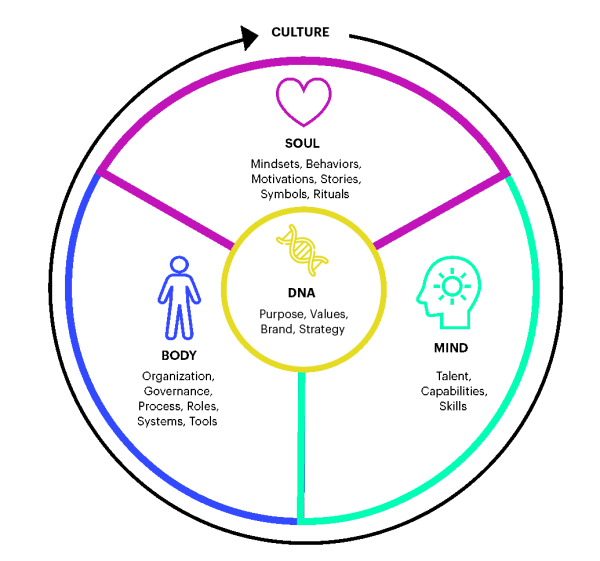BLOG
The Mind, Body and Soul of Healthcare’s Consumer-Centric Transformation
Change requires that leaders clarify purpose, articulate cultural expectations and alter incentives.
In today’s environment, patients are increasingly becoming “e-consumers” and that is a good thing. Despite its name, e-consumer is not a technical term. The concept of the “e-patient,” was coined in the 1990s by the late Tom Ferguson, M.D., an American physician who advocated for increasing the role of the patient in managing their own healthcare. E-patients, he says, are empowered, engaged, equipped and enabled. While the concept of the e-patient is limited to direct interactions with healthcare organizations, we have expanded and evolved it into the e-consumer. Read more here.
If healthcare organizations are to serve the e-consumer and engage, empower, equip and enable them, they too will need to make a shift by putting the consumer at the center of all they do.
Challenges of Consumer-Centric Healthcare
- Expanding from patient-first to consumer-first thinking.
- Being consumer-first even when it conflicts with being physician-first.
Neither is an easy task, and both demand a change in both organization and culture for most healthcare organizations.
Our colleague Tony Fross writes about the “mind, body and soul” of digital transformation, but this model is also relevant for the consumer-centric healthcare transformation (digital or otherwise). In this Prophet model, an organization first determines what it wants its DNA to be – its purpose, its brand proposition and/or its strategic plan to win. Next, it goes to work on the “mind” (its talent, capabilities, and skills), the “body” (governance, process and tools) and the “soul” (its values, behaviors and rituals).

In interviews with over 70 healthcare executives for the book “Making the Healthcare Shift: The Transformation to Consumer-Centricity,” we found changing the organizations’ mind, body and soul to be burning issues, particularly among the CEOs that we spoke with.
Based on our findings, to be a consumer-centric healthcare organization, you must take the following steps:
1. Inspire the Team
Healthcare organizations may have a vision of where they want to go, but they need internal support to get there. “We didn’t develop a consumer- and patient-centric strategy for the sake of hanging it up on the wall,” says Kevin Brown, President and CEO of Piedmont Healthcare. “The patient is at the center of all that we do. We’re living and breathing it. It is how we manage, run meetings, prioritize initiatives, approve capital, hire talent.” Consumer-centric healthcare transformation must be activated at the ground level, and healthcare organizations can successfully inspire their employees in several ways; for example, demonstrate leadership role modeling, codify cultural expectations, co-create cultural expectations and make it personal.
Leadership Teams Need to Model Consumer-Centric Behaviors
Inspiring employees to embrace consumer-centricity requires vocal leaders, who demonstrate their commitment through actions. It is important to have leaders who are on board with pursuing consumer-centricity, as their behaviors set a precedent for the broader organization.
Articulate Cultural Expectations
Much like an organization’s definition of consumer-centricity, a consumer-obsessed culture is most impactful when outlined in a tangible manner and built into the organization’s processes. By articulating the culture through behavioral expectations, organizations can help employees understand what consumer-centricity means to them and what it looks like when carried out on a day-to-day basis.
“The patient is at the center of all that we do. We’re living and breathing it. It is how we manage, run meetings, prioritize initiatives, approve capital, hire talent.”
Tap Employees for New Definitions
In addition to articulating what consumer-centricity means, employees must derive personal meaning from it. That is particularly important, as employees are often the ones who interact with consumers and care for patients. Leadership can help employees find personal meaning through co-creation. After a merger, Indiana University Health (IUH) needed to integrate acquired and legacy cultures. The organization took the time to understand the needs, wants, and aspirations, both personally and professionally, of their employees to co-create a promise that was common to both its employees and members of the communities in which they lived. “Not everyone got the old promise, particularly our professional staff. With [the new one], everyone gets it. Can we show that we’re reinforcing this promise with actions and decisions? We have to do it for every patient, every interaction. That’s the next big step we’re working through,” says CEO Dennis Murphy.
Make Consumer-Centric Healthcare Personal
There is no question that healthcare is personal. Whether undergoing treatment or taking care of a sick loved one, we all experience healthcare at a deeply individual level. Sometimes, organizations can make consumer-centricity more powerful when leaders emphasize the personal aspect. That requires leaders to find their own source of inspiration so they can constantly remind the organization who they are serving each day, why their work matters and why the experience should be among the best in any category.
2. Enable Successful Employers
The executives we interviewed described many ways to enable their employees, including creating new working environments, reimagining traditional business functions and putting purpose over process.
Create Environments That Reinforce the Culture You Want
As healthcare evolves, the demands of employees at healthcare organizations need to evolve as well – and in some cases, change altogether. To solve that challenge, leaders are spending time with companies like Google to understand and replicate some aspects of the culture that those organizations have created to enable both digitally-minded and healthcare-minded people to thrive. If it takes bean bags and dartboards and modifying the dress code, so be it.
Remake Functions and Functional Expectations
In an effort to better address consumers’ questions at their first touchpoint, Florida Blue revamped its customer-service function. By investing in systems that aggregate data across formerly disparate platforms, employees were now empowered with the right tools and information to answer questions, as well as offer solutions and value outside of the immediate issue at hand. The tools don’t just enable employees to do their job; instead, they enable employees to do their job in service of the consumer, which ensures both internal and external impact.
Demand Focus on Purpose Over Process
As healthcare organizations shift their mindset, they may find that their current processes are not conducive to consumer-centricity. Great processes, whether operational or strategic, should be informed by asking how the organization can deliver the best outcome for consumers. Starting with this question leads to clarity of purpose for building a consumer-centered organization. This purpose-first, process-second philosophy better enables employees to deliver on a consumer-centric strategy instead of being inhibited by legacy processes and protocols. Healthcare organizations can empower employees to drive consumer-centricity by ensuring process doesn’t get in the way of progress (or purpose).
3. Incentivize the Team
Once employees have embraced consumer-centricity and have the tools to deliver it, they still may require an extra push to act. For some, cultural transformation requires an enormous shift in their day-to-day lives. Organizations can help by incentivizing their employees and teams personally, professionally and financially.
Establish Metrics That Drive Change
Mobilizing around consumer-centricity requires top-to-bottom alignment on common goals. Organizations need to establish clear metrics that reinforce consumer-centricity to the overall business strategy. If organizations value and reward only non-consumer metrics like revenue or operating efficiency, then progress on those metrics is all that will be delivered. Having consumer metrics, even ones as simple as satisfaction, is critical to showing and driving a true commitment to consumer-centricity. It changes employees’ motivations and behaviors, which are both critical components of culture.
Leaders are rethinking what they measure, moving from measures tied to satisfaction (e.g., Hospital Consumer Assessment of Healthcare Providers and System, NHS Patient Satisfaction Surveys) to measures tied to loyalty (e.g., Net Promoter Score or NPS). Relationship-oriented metrics help paint a fuller picture of the experience and will compel functions across the organization to establish ways of working that address the experience holistically.
Link New Strategies to People’s Pay
Putting compensation and promotions on the line is a sure-fire way to change behavior. However, incentives alone are not enough to drive results. Instilling lasting cultural change requires that employees have a clear understanding of specific performance objectives, behaviors and actions needed to drive improvements tied to consumer-centricity.
To set a foundation for its cultural transformation, Anthem looked at its key metrics and realized that, while consumer-centric measures were in place, the organization lacked clarity around creating real change. Executive leadership endorsed NPS as its key metric and tied it to executive compensation, resulting in a focus on relationship building with consumers. “Once it affected everyone’s bonus, the demand to meet with and discuss the metric took off,” says Doug Cottings, Staff Vice President, Market Strategy & Insights at Anthem.
FINAL THOUGHTS
While changing the mind, body and soul of an organization is difficult, there are tangible steps that organizations can take to get started. With employees who understand, embrace and live consumer-centricity, organizations can both win with and create more e-consumers.
Ready to partner with us to become a consumer-centric healthcare organization? Reach out today.
